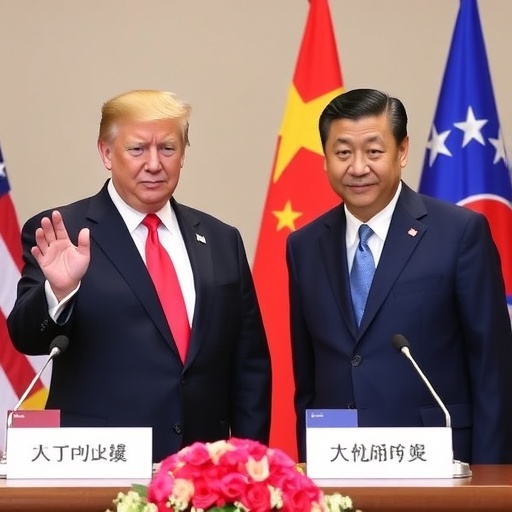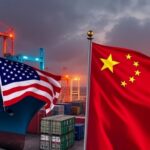Trump and Xi Jinping to Finalize Landmark Trade Agreement at South Korea Summit, Easing Tariffs and Rare Earth Tensions
In a move that could reshape global trade dynamics, President Donald Trump and Chinese President Xi Jinping are scheduled to convene at a high-stakes summit in South Korea next week, aiming to ink a long-awaited trade agreement. This pivotal meeting comes after months of grueling negotiations marked by escalating tariffs and supply chain disruptions, promising relief for U.S. industries battered by the ongoing trade war. Sources close to the White House indicate that the deal will include significant tariff reductions and new commitments on rare earth mineral exports, potentially averting further economic fallout for American farmers and manufacturers.
From Trade War Escalation to Diplomatic Thaw
The path to this South Korea summit has been anything but smooth. Since 2018, the U.S.-China trade war has seen tariffs imposed on over $360 billion in Chinese goods by the Trump administration, with China retaliating against $110 billion of American exports. These measures, intended to address intellectual property theft and unfair trade practices, have instead inflicted pain on both economies. U.S. soybean exports to China, for instance, plummeted by 74% in 2018, leaving farmers in the Midwest grappling with surplus crops and mounting debts.
Negotiations hit a fever pitch earlier this year when talks in Washington nearly collapsed over disagreements on enforcement mechanisms. “We’ve been on the brink more times than I can count,” a senior U.S. trade official told reporters anonymously. “But both sides recognize that prolonged uncertainty is toxic for businesses.” The decision to host the summit in Seoul, a neutral ground leveraging South Korea’s role as a key ally to both nations, underscores the diplomatic maneuvering at play. South Korean President Yoon Suk-yeol has positioned his country as a mediator, with his office confirming that the venue was chosen to facilitate “candid and productive dialogue.”
Historical context adds weight to the occasion. The last major U.S.-China summit under Trump occurred in 2019 at the G20 in Osaka, where a fragile truce was declared. Yet, that agreement faltered amid accusations of non-compliance. This time, insiders suggest a more robust framework, including phased tariff rollbacks starting with agricultural products. According to the Peterson Institute for International Economics, full implementation could boost U.S. GDP by 0.2% annually, while easing pressures on global inflation driven by supply shortages.
Unpacking the Core Elements of the Trade Agreement
At the heart of the impending trade agreement are concessions designed to de-escalate the tariff standoff and secure critical supply chains. The deal is expected to reduce U.S. tariffs on $200 billion worth of Chinese imports from 25% to 10% over the next 18 months, with reciprocal cuts from Beijing on American automobiles and electronics. This phased approach aims to prevent market shocks, allowing businesses time to adjust.
A standout provision addresses China’s dominance in rare earth elements, which account for 80% of global supply and are essential for everything from electric vehicle batteries to military hardware. The agreement reportedly includes commitments from Xi Jinping’s government to lift export restrictions imposed in response to U.S. tech bans, ensuring stable flows to American firms like Apple and Tesla. “Rare earths are the new oil in the tech world,” noted Dr. Emily Chen, a supply chain expert at the Brookings Institution. “This clause could prevent a bottleneck that might have cost the U.S. economy up to $50 billion in lost productivity.”
Intellectual property protections form another pillar, with China agreeing to stricter enforcement against forced technology transfers—a long-standing grievance for U.S. companies. The deal also mandates increased purchases of U.S. goods, targeting $200 billion in additional imports over two years, including liquefied natural gas and semiconductors. These elements build on Phase One of the 2020 trade agreement, which has seen mixed results: while U.S. agricultural exports rebounded to $30 billion last year, compliance issues persist, as highlighted in a recent U.S. Trade Representative report.
To illustrate the stakes, consider the numbers: Tariffs have added an estimated $80 billion in annual costs to U.S. consumers and businesses since their inception. For Chinese exporters, retaliatory duties have squeezed profit margins, contributing to a 15% drop in manufacturing output in key provinces like Guangdong. The South Korea summit represents a potential turning point, with negotiators from both sides burned out but optimistic. “President Trump is going in with a strong hand,” said Commerce Secretary Gina Raimondo in a recent interview, emphasizing the leverage from America’s resilient economy.
U.S. Farmers on the Front Lines of Tariff Relief
No sector stands to gain more from this trade agreement than American agriculture, which has borne the brunt of the trade war’s fallout. In states like Iowa and Illinois, where soybeans and corn dominate, farmers have faced volatile prices and lost markets. The American Farm Bureau Federation reports that over 300,000 farming operations received $28 billion in federal aid between 2018 and 2021 to offset tariff damages, but many families still teeter on bankruptcy.
Under the proposed deal, China would commit to buying an additional 14 million metric tons of U.S. soybeans annually, restoring pre-trade war levels. This could inject $5 billion into rural economies, according to USDA projections. “We’ve planted the seeds of hope, but tariffs have been the drought,” said Iowa farmer Tom Reynolds, whose operation lost 40% of its revenue in 2019. “This summit could finally bring the rain.”
Beyond soybeans, the agreement targets pork and beef exports, which have surged 50% in recent years despite hurdles. However, challenges remain: Climate change and the lingering effects of African swine fever in China could temper demand. Experts like those at the University of Minnesota’s Center for International Food and Agricultural Policy warn that while tariff easing is a win, long-term diversification—such as new markets in Southeast Asia—is crucial. The South Korea summit, by stabilizing U.S.-China ties, might also open doors for trilateral agricultural pacts involving South Korea, a major importer of U.S. grains.
Emotional stories abound from the heartland. In Kansas, a fourth-generation wheat farmer shared with The New York Times how tariffs forced her to sell equipment to make ends meet. “We’re not just growing crops; we’re sustaining communities,” she said. The trade agreement’s success could revitalize these areas, reducing urban migration and bolstering food security worldwide.
Global Ripples: How the South Korea Summit Reshapes Supply Chains
The implications of the Trump-Xi trade agreement extend far beyond bilateral relations, influencing allies and adversaries alike. In Europe, where tariffs have indirectly raised costs for imported components, business leaders welcome the thaw. The German Marshall Fund estimates that a resolved U.S.-China spat could lower global shipping rates by 10-15%, easing inflation pressures exacerbated by the COVID-19 pandemic.
South Korea itself benefits as host, with its semiconductor industry—home to giants like Samsung—poised for gains from stabilized rare earth supplies. The summit’s location highlights Seoul’s growing geopolitical clout, bridging divides in a region shadowed by North Korean tensions. Japanese Prime Minister Fumio Kishida has expressed support, noting in a statement that “a stable U.S.-China relationship is foundational to Indo-Pacific prosperity.”
Yet, skeptics abound. Critics in Washington argue the deal doesn’t go far enough on human rights or subsidies for Chinese state-owned enterprises. A report from the Center for Strategic and International Studies warns of potential loopholes that could allow Beijing to skirt commitments, echoing Phase One’s shortcomings. On the flip side, Wall Street is bullish: The Dow Jones Industrial Average rose 1.2% on news of the summit, with analysts from Goldman Sachs forecasting a 0.5% uplift in corporate earnings if tariffs ease.
Environmental angles add intrigue. Rare earth mining’s ecological toll in China has drawn scrutiny, and the agreement includes provisions for sustainable sourcing, potentially aligning with Biden-era climate goals—though Trump has downplayed such emphases. Overall, the South Korea summit could catalyze a broader reconfiguration of global trade, reducing reliance on single suppliers and fostering resilient networks.
Expert Insights and the Road Ahead for U.S.-China Ties
As the world watches the South Korea summit unfold, economists and diplomats offer varied prognoses. “This isn’t just a trade deal; it’s a geopolitical reset,” opined former U.S. Ambassador to China Max Baucus in a CNN analysis. He predicts that successful finalization could pave the way for cooperation on issues like climate change and pandemics, areas where U.S.-China rivalry has stalled progress.
Challenges persist, however. Enforcement remains a flashpoint, with the U.S. pushing for an independent dispute resolution body. Quotes from Xi Jinping’s camp are muted, but state media has hinted at “mutual respect” as key. Trump’s personal rapport with Xi, forged during Mar-a-Lago summits, might prove decisive—though domestic politics, including midterm pressures, loom large.
Looking forward, the trade agreement could herald a new era of managed competition. If implemented, it might inspire similar pacts with other partners, such as the EU or India, fortifying U.S. economic security. For global trade, the summit signals a shift from confrontation to coexistence, with tariffs fading into a cautionary tale. As negotiators prepare in Seoul, the stakes couldn’t be higher: a breakthrough here could stabilize markets for years, benefiting consumers from California to Shanghai.
In the coming weeks, follow-up mechanisms will test the deal’s durability, potentially involving WTO oversight. For now, optimism tempers caution, with the international community holding its breath for what could be a defining moment in 21st-century economics.








